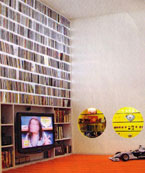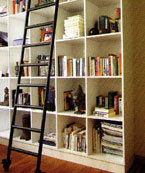|
Useful Storage Planning Guide and TipsThe storage planning guide on this page is based on personal experiences. I’ve chosen to touch on 2 key stages in our lives where storage planning is essential: for first time home owners and for the family home. First Time Home OwnersTo begin, most first homes tend to be on the small side. That means you start with a basic shortfall of space to put things. If you’re sharing accommodation with friends or a partner, that shortage of space is all the more acute. If your parents have enough room, you may want to sort and keep old belongings in an out-of-way location until you can give them a permanent home yourself. Else, I’d suggest that you be ruthless – discard or donate.
You’ll only become a means by which other people shed unwanted possession.
While she may want to keep her favorite cookbook, there’s no point in retaining 2 bread knives. Keep the one that works better or newer or better quality. Here’re some more additional points to consider in this storage planning guide: • When sharing your new home with another person, there are bound to be differences in basic attitudes to possessions and their organization. If you do not want to fight over these issues, it is best to try to arrange matters so that each has some personal space. • Built-in or fitted storage, preferably concealed for a more streamlined finish, makes the most of limited space. Rather than buy a number of individual items of storage furniture, which eat up floor area and are visually distracting, spend the money on putting up shelves and building cupboard. For example, the roller ladder below allows access to the upper compartments of the built-in shelves. The picture on the left shows how you can showcase and store an audio CD collection - vertically, like books. This way, they take up less space which makes it easier to add to your collection. 

• Consider hiring off-site storage facilities for any possessions that you don’t have room for at the present time, but would like to retain for future use (e.g. tax receipts and documents). • If you tend to spend time away from home – work during the day and out socializing at night – it’s good to spend time during the week to pack and clean up. Else, clutter can become overwhelming before you realize.
Storage Planning Guide for Family HomeWith rapid changes to family life, here’s a storage planning guide for the family home. With growing children, it not difficult to find yourself reviewing your existing possessions and storage needs. Each stage of their development means their last stage’s clothing, toys, books and games becomes redundant. This also includes furnishings such as cots or cribs, high chairs and beds. While you may make the decisions with younger children, I’d suggest you seek the views of older children on what is kept and what is to be give away. Those with children will know that unless they’re taught to respect their possessions, most children will leave the mess they’ve created. This means difficulty in looking for important documents and homework when you need it. Thus, it’s important to provide accessible storage for children such as baskets and low-level shelves. Some key points to consider: • Encourage regular clean out sessions to keep tabs of whatever is outgrown or in surplus. This applies to adult’s possessions. • Modular storage containers can be a good way to organize children’s games, puzzles and art supplies, as well as CD and DVD collections. • As soon as children are old enough, enlist their help in tidying up. Don’t attempt to enforce a standard or order they have no hope of achieving, but don’t allow them to be sloppy either. • Most children treasure their handicraft work. You may store their paintings and drawings in folders until large scale attempts take over. I’d suggest taking digital photos of these artwork before disposing the pieces. That ensures an effective storage of memories. You may even develop the pictures into photos for storage in albums later.
You may also want to take a look at:
Click on highlighted text to return to the top of storage planning guide |



